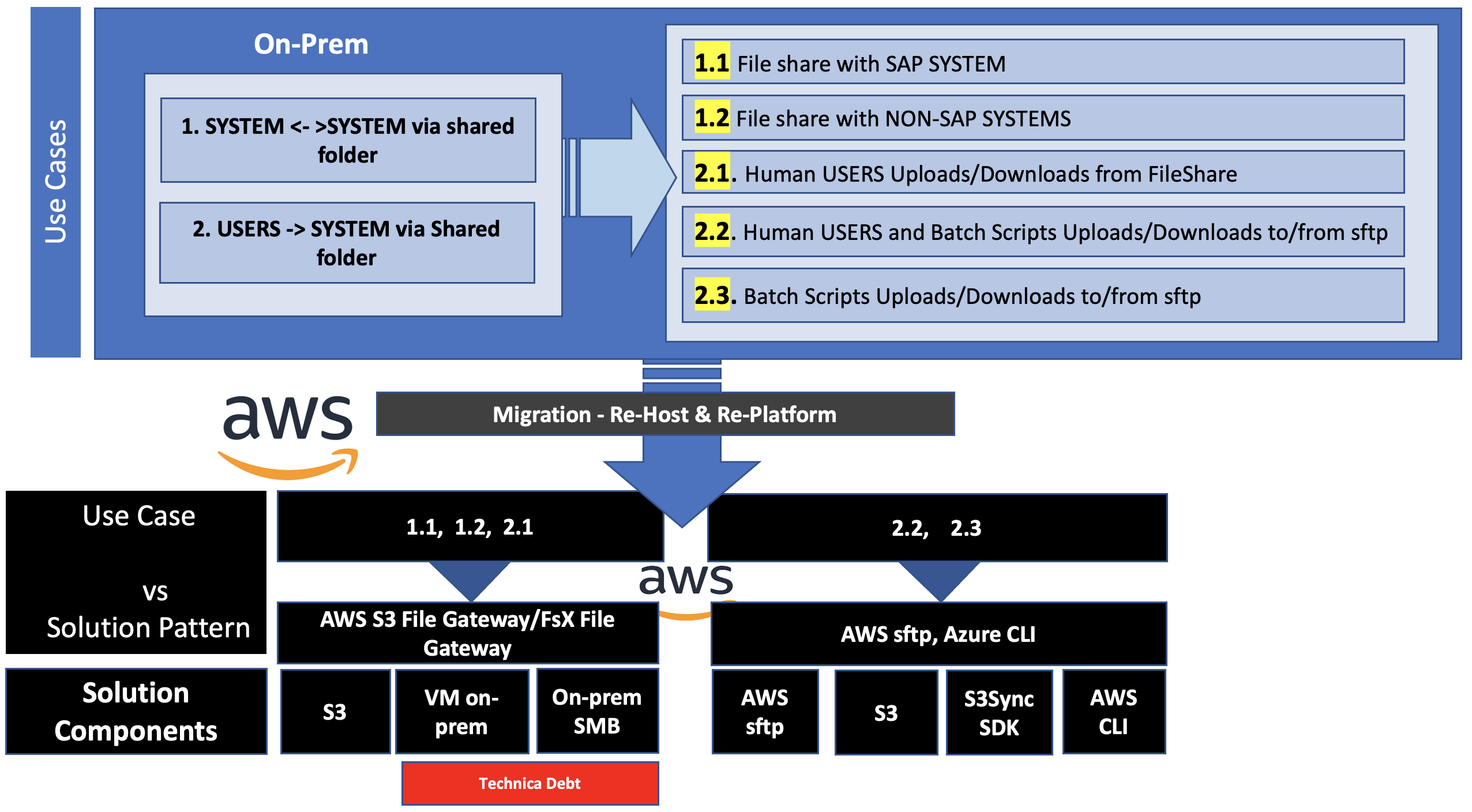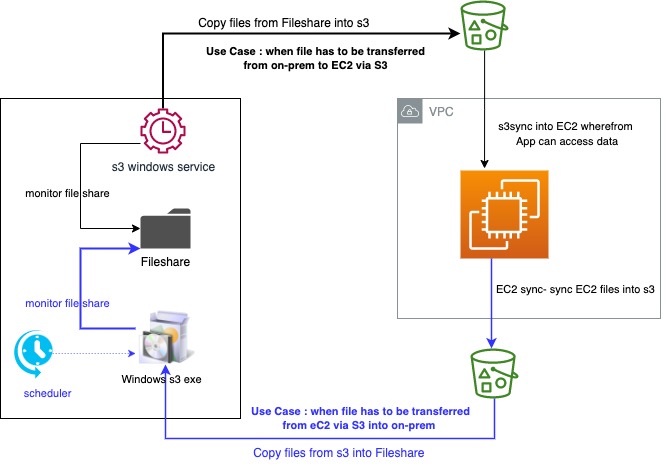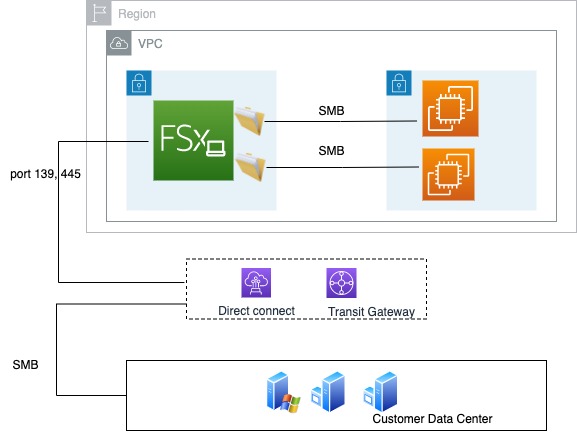Hybrid File Integration on AWS, Technical Debt, and Solution Approach
Some of the key architecture decisions regarding hybrid integration are with reference to FileShare between the cloud and on-prem systems/users.
Join the DZone community and get the full member experience.
Join For FreeIntroduction
As we move/migrate applications from on-prem to the cloud, some of the key architecture decisions regarding hybrid integration are with reference to FileShare between the cloud and on-prem systems/users.
When a part of the ecosystem goes to the cloud, it's important to have the file sharing seamless, efficient, and performant yet cost-effective — driven by a cloud-native solution approach.
The decision to use a target solution for FileShare varies by use case. This document provides insight into various use cases of file-based integration, services offered by AWS, potential technical debt, and solution approaches. The technical debt referred to here is related to the presence of a solution component in the on-prem data center. The removal of these technical debts is critical to the closure of the data center as well as very high license fees and infra costs associated with resources.
Use cases are primarily categorized into the following:
- User to/from system using FileShare
- System to/from system using FileShare
User and Operational Impact
It needs to be noted that there may be operational changes in scenarios of how users used to upload/download files without compromising authentication/authorization or access related to security. A user operations handbook is created for these solution patterns, and users have trained in the Sandbox environment. These users are business users, and the solution patterns and operational changes are agreed upon with them before design and implementation.
Overview — File-Based Integration and AWS Solution Options

S3 FileGateway: How It Works
- AWS S3 FileGateway needs an on-prem appliance (VM). It acts as S3 FileGateway(FG) server
- The on-prem systems/users create an SMB Fileshare with this server’s specific folders
- The FileGateway server, on another side, integrates with S3. Internally, there is a replication that happens between FG Server’s configured fodders and S3.
- The AWS-hosted application sends/receives data from S3 using s3sync/s3copy SDK.
- This is AWS managed service details of integration between S3, and FileGateway server, replication, etc., are managed by AWS.
FsX Server: How It Works
- Used when high-speed, large-volume file transfer is required with no latency
- AWS FsX Server needs an on-prem appliance (VM). It acts as an FsX FileGateway client.
- The on-prem system/user creates an SMB Fileshare with this server’s specific folders.
- On another side, FsX Server is provisioned within a Subnet of the Application VPC.
- The application servers/EC2 instances have an SMB share with FsX Server
Solution Constraints
- Critical Technical Debt: This appliance hosting the FileGateway/Fsx FileGateway Server is an additional infrastructure on data center — has additional cost/maintenance and a technical debt when a client wants to close the data canter.
- For S3 FlleGateways, there is a latency of x mins for the replication between S3 and SharedFolder on the FileGateway Server.
- FsX FileServer-based solution is an expensive solution — hence, to be considered carefully.
Below is the list of detailed use cases and solution approaches:
| Use Case | Solution Pattern |
| 1.1. AWS hosted Application - Integration with SAP | SAP is on Cloud 1.1 a: Use SAP PI Advantco adaptor and copy files to/from s3. on the other side, files can be uploaded /downloaded to/from s3. 1.1b: If there is no SAP PI, we can use S3 Cross Account Replication between Application VPC/Account and SAP VPC/Account. Refer to https://docs.aws.amazon.com/AmazonS3/latest/userguide/replication-walkthrough-2.html |
SAP is on-prem — options 1.1 c: Use SAP PI Advantco adaptor and copy files to/from s3. On the other side, files can be uploaded /downloaded to/from s3. 1.1 D: One can use third-party software like MoveIT to copy files from SAP into AWS s3 and vice Versa |
|
| 1.2 AWS hosted Application –Integration with Non-SAP system | 1.2a: If both source and destination are in the same customer domain, use Use Windows s3 sync services on the on-prem server (or on EC2 in cloud) to push/pull files to/from AWS s3.
1.2b: If the on-prem system does not allow Windows s3 sync service to be installed, use the FsX server-based integration and open SMB port(139,445) for the CIDR range of system/laptop. Allow SMB traffic over Transit Gateway, firewall, and AWS Direct Connect to reach on-premise servers. However, this will depend on the client's security policy.
Note: If the Integrating party is an external/Third party, the integration will be done through sftp, ideally. Refer to 2.2 |
| 2.1 Users share files from/to a shared Location | 2.1 If the Users are manually downloading/uploading files from the AWS server, use S3 SSO with Azure AD (an Enterprise SSO application having S3 URL, authentication/authorization through Azure AD. The access to the backend S3 is controlled by AD (Active Directory group) to ensure RoleBased Access Control and the folder structure of FileShare is managed.
|
| 2.2. Human USERS Uploads/Download to/from sftp | 2.2. Use AWS sftp, and expose the URL to users. The users are authenticated through a service account with proper IAM(Identity Access Management roles. The sftp is backed by AWS S3. The content from s3 can be written (or read from) to AWS-hosted EC2/EBS using an S3sync AWS SDK. |
| 2.3. External system runs a batch script to integrate with sftp | If an external system interacts with sftp, is programmatically access needed — Embed Programmatic access to AWS sftp through Script. However, if there is a third-party software used to connect to sftp, the syntax/URL/Port expected by that software should be aligned with AWS sftp parameters. Alternatively, download AWS CLI, and use Access Key and Secret Key ID to connect with S3 directly (instead of sftp). |
Published at DZone with permission of Sukanta Paul. See the original article here.
Opinions expressed by DZone contributors are their own.




Comments